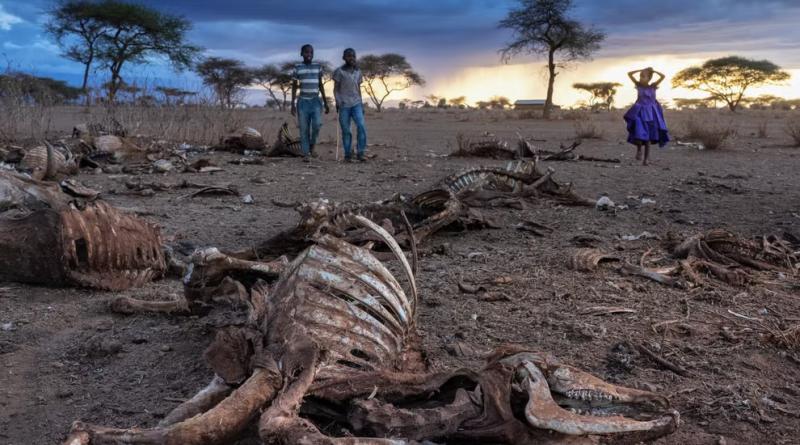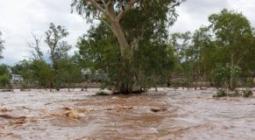Everything is dead’: Animal carcasses litter Kenyan landscape as megadrought and climate change collide

Overgrazing and a historic drought worsened by the climate crisis has decimated wildlife, leaving millions of people on the brink of famine in the Horn of Africa
As the Horn of Africa struggles with its worst drought in 40 years, nature seems to have turned on its head in Kenya.
Hardy, drought-resistant species like zebras and elephants are dropping dead en masse. Vultures are so fat from feasting on carrion they can barely fly.
In southern Kenya, home to some of the world’s most productive grasslands, bushes stretch for miles without a leaf in sight as animals collapse and die from starvation in the dust near Amboseli National Park.
These are some of the shocking sights captured by wildlife photographer Charlie Hamilton James, who traveled to the region earlier this month alongside the eminent Kenyan conservationist Dr Paula Kahumbu, to document the drought with support from the National Geographic Society.
“Everything is dead,” the photographer told The Independent. “There’s just nothing to eat. It’s parched desert.”
He recalled seeing a zebra who had finally made it to a watering hole, only to drop dead.
“You’d see a lot of dead animals around the watering holes,” he added. “I don’t know what it is. They finally drink water then they just collapse and die.”
But it’s not just a tragedy for the region’s wildlife and agriculture. The combination of drought, livestock death, and ecosystem change are already having a massive impact on the region’s culture, economy, and people. The multi-faceted crisis is a reminder of the ways that climate change can tip already sensitive systems into collapse.
Some 21m people are facing starvation in Somalia, Ethiopia, and Kenya, as the region experiences its fifth successive failed rainy season.
“We are on the brink of an unprecedented humanitarian catastrophe,” Dr Guleid Artan, director of the World Meteorological Organization’s regional climate centre for East Africa, said this summer.
In Kenya, the drought has killed an estimated 2.5m livestock, and the effects of the crisis appear to be moving from the drier north further south and into the country’s normally lush grasslands. In some parts of the country, there hasn’t been major rain for the last three years.
According Dr Kahumbu, a National Geographic Explorer and CEO conservation organisation WildlifeDirect, the roots of the crisis go deeper than climate change alone.
Overgrazing by cattle and other livestock has worn out the soil in various parts of Kenya, stripping grasslands of their resiliency and biodiversity, and allowing the proliferation of tough plants and invasive species that animals avoid using as food.
When a historic drought comes along, livestock and wildlife alike find themselves without enough food to survive.
Grass, unlike most plants, grows from the roots instead of the tips, allowing it to bounce back quickly from even severe ecosystem challenges. But the overgrazing has been so profound there’s little grass left to recover.
“A system might be damaged or degraded by overgrazing, but climate change can throw it over the tipping point. That’s what we see in northern Kenya, and that’s what we’re beginning to see in southern Kenya,” Dr Kahumbu said.
“We’ve never seen that before in southern Kenya. We’ve never seen that level of catastrophic collapse, when you wake up in the morning and the ground is littered with dead animals.”
Officials were long warned that such conditions were heading the region’s way, but Dr Kahumbu says the issue was “invisible” for years, owing to the Covid pandemic, elections, and the initial impacts hitting animals but not yet causing widespread human death or starvation.
Now, however, those human impacts are coming to the forefront. Children whose families depended on their livestock for food or income are showing up to school hungry, or leaving because they can’t pay tuition fees. Rural people are being forced to move to cities to find work.
The semi-nomadic Maasai people, known for their cattle herds, have seen a core part of their culture threatened and their fortunes wiped away in an instant. Healthy cows normally worth $1000 now barely sell for $10 in their emaciated state, forcing some individuals to sell their lands.
These former pastures will likely be turned into agricultural sites, though farmers in the country report hungry animals seeking out their crops as the drought threatens the creatures’ normal food supplies.
“People who were wealthy, who had lots of livestock, are suddenly very poor. They can’t take care of their families,” Dr Kahumbu said.
Mr James, the photographer, recalled driving through Maasai communities outside of Amboseli National Park and speaking with a man whose herd of 390 cows had been reduced to just 43 animals, which appeared on their last legs.
“There were just dead cows there. I mean just hundreds of them,” Mr James said. “There were just dry dead cows with dogs eating them, right in the middle of the community. They had so many, they had no way of getting rid of them.”
In Kenya, the government has provided immediate relief of food aid for people and hay bales for livestock. But officials haven’t yet put forth a national land management strategy to address the crisis, and they’ve provided lackluster enforcement of environmental conservation laws. This effort has been supported by sporadic private efforts to aid landowners and wildlife stocks, though nothing has yet matched the scale of the problem.
“What they haven’t done is put in place the necessary response to the fact that the land is degraded. They haven’t come out with a policy on things like recovery of those grasslands,” Dr Kahumbu said.
“If this isn’t done what will happen is, the cattle will simply be brought back, more cattle will be bought, as soon as the grass starts growing again.”
“That’s our fear,” she continued. “The government hasn’t said anything about addressing the long term…This is such a large-scale probable. It can’t be solved on a tiny-acreage-by-tiny-acreage basis. It has to be solved on a national level.”
On the international front, things don’t look much better.
“The US, who take a whacking quite often and sometimes for good reason, are the only country who stepped up on this hunger crisis in East Africa,” David Miliband, the president of the International Rescue Committee, told The Independent last week. “The Americans are leading and no one is following.”
Mr James hopes that his photographs will alert governments and media outlets around the world to the crisis in the region.
“The problem is massive and the response is tiny,” he said. “It’s tiny really in comparison compared to the scale of the problem.”
cover photo:
Skeletons of cows litter the landscape around near Amboseli National Park in southern Kenya





